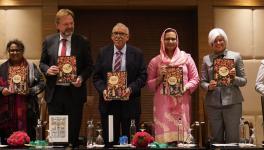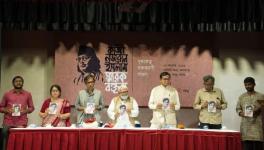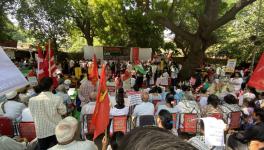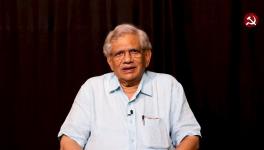Devadasis in Karnataka Fight Back
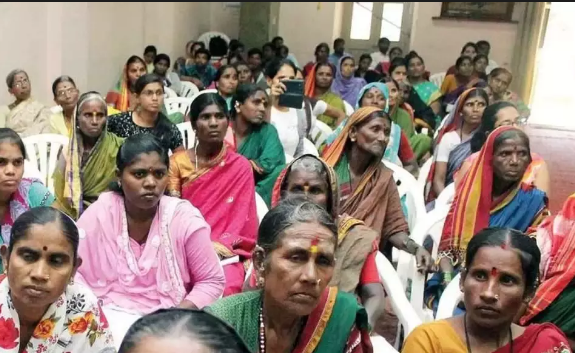
Image Coutesy: Times Of India
The Devadasi system, a practice that has been a part of southern Indian life for ages, still continues in parts of Karnataka, Tamil Nadu, Goa, Andhra Pradesh and Telangana. On January 19, thousands of devadasis (servants of God) from different regions of Karnataka demonstrated at Hosapete in Ballari district highlighting the plight of their struggle.
The demonstration and rally were held keeping in line with the 3rd State Conference of Karnataka Rajya Devadasi Mahileyara Vimochana Sangha (KRDMVS) {Karnataka State Devadasi Women’s Liberation} which has been leading the struggle for the rights of devadasis in the state since 2006.
The Karnataka Devadasis (Prohibition of Dedication) Act had come into effect in 1982 abolishing the devadasi system. However, the system is still prevailing in the state, mainly in the northern belt, with the silent blessings of landowning classes as well as the upper and dominant castes. To fulfill their vested interests, they have even spread the fear that “if girls do not become devadasis, God will be angry”.
What is the Devadasi System?
These girls, who are dedicated to God, are considered as married to a particular deity. In simpler words, this means that they cannot marry any mortal. The girls are forced to “dedicate” themselves at a very young age. When these young girls attain puberty, their virginity is sold to the highest bidder as dictated by the devadasi system. The younger ones face the worst form of exploitation, forced to become sex slaves. Mostly women from the dalit and the oppressed community become the victims of this exploitative practice.
“In Madoor, there is a temple dedicated to Durgamma. One day, the temple priest had a dream that there are two girls who have to be dedicated to this goddess. The priest then sent a person to the girls’ family to inform them about the dream and convince the family to dedicate the girls to the goddess. When the parents asked about the girls’ future, the village head and priest said that they would be given houses, land and money,” said Maalamma, the state general secretary of KRDMVS, narrating how girls are being forced to be the slaves of God.
Malamma, who has been in the forefront of the organisation for a long time, added, “When we came to know about the incident, our organisation had visited the region and stopped them from dedicating the girls to God, pushing them to be sex slaves.”
The Movement Against Devadasi System
The movement against the devadasi system had been first initiated in the 18th century by Nalvadi Krishna Raja Wadiyar, the then Maharaja of Mysore, by fighting the Gajja puja. Gajja puja- Gajja means anklet- was a part of the devadasi system. According to the custom, if a girl ties Gajja in front a particular deity, then that deity becomes her husband.
Also Read: “The Roots of the Caste System are Getting Deeper...”
Later, Left parties, especially the Communist Party of India (Marxist) [CPI(M)], started their campaign against the devadasi system. “We have been continuing our struggle against the devadasi system for the last 20 years. In Ballari, Koppal and some other districts, we started organising devadasis before 2000. In 2006, a state level organisation, KRDMVS- the only state level organisation of Devadasis in the country, had been formed for devadasis,” said VJK Nair from CPI(M) who has been associated with the movement of the devadasis for a long time.
In the recently concluded conference, the devadasis reiterated their 12-point demand charter which includes effective abolition of Devadasi System in the state and payment of Rs. 5,000 per month as pension to all Devadasi women. So far, the women have launched many agitations and protests in the state. After the mass dharna in Bengaluru on June 12, 2007, the then state government was forced to provide pensions and social security measures. However, the pension amount was a meagre Rs. 1,500 per month.
Talking about the demands, U. Basavaraj, the state secretary of CPI(M) said, “We, in support of devadasi women, demand Rs. 5,000 per month as pension, strengthening of the existing act of 1982 and five acres of land for women who have stepped out of the devadasi system along with others.”
At present, women who are 45 years old and above get the pension. “We demand that the age limit should be brought to 24-25. Apart from that, nearly 45,000 women are still out of the scheme. For that, a fresh survey should be conducted which includes the children of devadasis so that they can avail the social security benefits,” said Maalamma.
Nearly one lakh devadasis are there in Karnataka itself. The Tungabhadra river belt river area, which includes parts of the old Bombay presidency area, Madras presidency area as well as areas under the princely state of Nizam that spread across Karnataka, Telangana and Andhra Pradesh, still practices the devadasi system.
Earlier, two surveys- one in 1993-94 and another one in 2007-08- had been conducted. As per the survey, a very marginal number of people are entitled to legal protection, social security and all health benefits.
Narrating his own experience, Huchangi Prasad, a young Kannada writer who hails from a devadasi family said, “Though there are 30 devadasi women in my village, Sindhanur, the government says only five devadasis are there. So, only five devadasis out of 30 are entitled to legal protection, social security and all health benefits.”
“Many are HIV positive. But they are not getting any health benefits,” Prasad added saying that one of his elder sisters is HIV-positive.
The demand to rephrase the 1982 Act which criminalises devadasis have been there for a while. “Instead of devadasis, the people who are forcing girls to be devadasis should be penalised- like mostly upper and dominant castes, pujaris, pandits and religious heads. Even family members should be penalised. How can those girls, who had been dedicated at the age of five or six, be penalised?” added Maalamma.
Also Read: Dilution of SC/ST Act and the Impact on Adivasis
As of now, devadasis get financial aid from the state for building homes. Since the practice prevails in other states too, organisations working for devadasis are demanding the centre’s involvement in this issue. They are also demanding a separate budget allocation from the centre.
Another major demand is that the children of the devadasis should get inheritance rights over the property of their biological father. “Upper caste people and politicians happen to be the biological fathers of most the kids,” said VJK Nair.
Financial support of Rs. 5 lakh for the marriage of girl children of the devadasi women, rehabilitation of families, and employment of the young educated children from devadasi families as volunteers in the punarvasathi kendra are the other main demands.
Simply, the ancient inhuman practice that entitles a supply of concubines to upper caste and wealthy men under the shield of religion is still crushing girls from the oppressed classes and castes.
Read More: Karnataka to Introduce Bill against Social Evils for the Third Time
Get the latest reports & analysis with people's perspective on Protests, movements & deep analytical videos, discussions of the current affairs in your Telegram app. Subscribe to NewsClick's Telegram channel & get Real-Time updates on stories, as they get published on our website.









